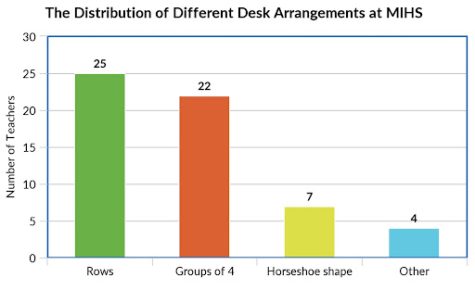
In a recent survey among MIHS teachers, 51% of respondents said they arrange their desks in rows. However, research and teacher experiences suggest that table groups are better than rows for student learning.

According to the Yale Poorvu Center for Teaching and Learning, arranging students’ desks in rows “results in instructors spending more time in lecture and students demonstrating less active engagement.” In contrast, in small groups or pods of students, “instructors and students [engage] in more active learning activities, resulting in improved learning outcomes.”
“Facilitating frequent comfortable interaction among my students was always the most important thing to me in my seating arrangement,” Spanish teacher and instructional coach Kelsey Cochran said. “I feel that for myself, group arrangements achieve that the best … I know that in my classroom, rows would not allow me to achieve my goals.”
For world language courses, it is crucial that students communicate in the foreign language with each other, and so table groups are beneficial. Teaching a language class in rows 100% of the time might teach students how to read and write, but it would ignore the important skills of speaking and listening, which are more practical skills post-high school.
Even for other types of high school courses, table groups can be more effective than rows— for example, in English and social studies courses, where class discussions are vital to learning. When direct teacher instruction is necessary, the desks can be arranged in rows, and then during group projects or discussions, the desks can be shifted into groups or a large horseshoe shape.
Now, math and science are different. These subjects are more individual, and less discussion-based, so at first glance, it may seem like it doesn’t make sense to arrange the seats in groups. Also, because of the high amount of teacher instruction in these subjects, it can be difficult for students to see the lesson if their seat doesn’t face the front of the classroom.
However, collaboration in math and science is still important, as listening to others encourages students to view problems from different perspectives. Original questions and solutions often lie at the intersection of different points of view.
“I taught [in rows] my first year or two, and it quickly became apparent that students were very isolated,” math teacher Lynn Adsit said.
Adsit then shifted the desks into groups of four and noticed that students helped answer their classmates’ questions.
“Math shouldn’t be done in isolation. When you talk with other people, ideas can be deepened or clarified. Some of your thinking could change because of what someone asks you, or someone else shares while they’re doing the problems … so [table groups] benefit just about everybody in the class,” Adsit said.
A collaborative math class teaches students to be problem-solvers instead of mere homework-completers. Therefore, math teachers should arrange their seats in groups of two or four students (perhaps still facing the front of the classroom) to facilitate collaboration.
“I taught with the students in pairs facing me, but I had outside areas where student groups would meet for a lab or discussions,” former science teacher and instructional coach Jamie Cooke said. “That worked well for me, so I would have students facing me for direct instruction, and I would direct them to the sides for group work.”
“As a school, we’ve had a whole movement this year on student-centered learning, to promote that … collaboration is very important for learning,” Cooke added.
So, teachers: if you arrange your students’ desks individually in rows, rethink that choice. Move the seats into pairs or groups of four, and when group activities are happening (which should be relatively frequently), direct your students to move their seats so that they can face one another. The class will start to become more collaborative and engaged, improving students’ academic performance.









Arman Najafian • Jun 12, 2022 at 2:49 pm
I definitely get where you are coming from, I myself love table groups because I find it more engaging. Ashwin you did a great job with this article and really helped open up the reason behind certain seating arrangements and why they should be changed.
Zoya • Jun 8, 2022 at 3:17 pm
this is a great article and sparked a lot of interest in things I didn’t think about before.
Julia Hauge • Jun 1, 2022 at 3:20 pm
This is so interesting and well-written! I have always felt that I learn better in classes with table groups, and this article helped me understand why that is.
Jordan • May 31, 2022 at 12:14 pm
awesome article Ashwin- I especially love the graph!
Betty • May 26, 2022 at 12:19 pm
great article ashwin, lots of good evidence!